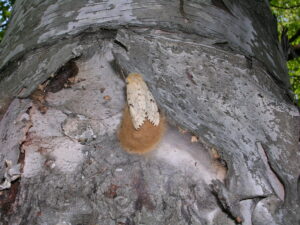By Bill McNee, forest health specialist, Oshkosh, bill.mcnee@wisconsin.gov, 920-360-0942
The summer of 2020 saw a major rebound of the gypsy moth population after several years of weather conditions that were unfavorable for the non-native, defoliating pest. A mild winter and average summer temperatures/precipitation during the caterpillar stage were all favorable for a population increase.

Female moth laying eggs on tree trunk.
Reports of nuisance caterpillars and adult moths increased dramatically from the Green Bay area south to Kenosha as well as from the Madison area. Scattered, individual reports also came in from other counties in southern and central Wisconsin. Defoliation was only reported from two rural areas in Fond du Lac County.
The numerous reports of egg-laying female moths, and infrequent reports of disease-killed caterpillars, are good indicators that populations could be even higher in 2021, though this is subject to future weather conditions.
This fall is an excellent time to look for and dispose of gypsy moth egg masses that were produced by adult moths this summer. Gypsy moth egg masses are tan-colored lumps about the size of a nickel or quarter and can be found on trees, buildings and other outdoor objects. They may also be found in protected places such as firewood piles and bird houses. Surveying for egg masses helps property owners predict next summer’s insect populations and take action if appropriate. More egg masses will be visible if property owners wait until leaves have fallen from the trees. Contacting an arborist or forester may be appropriate if many masses are present.
When egg masses are found, remove or treat those safely within reach. If only a few egg masses are seen, accessible ones can be sprayed with horticultural oil (available online or at many home and garden centers) or gently scraped into a container of soapy water to soak for a few days before being discarded in the trash. Do not use motor oil or mineral oil, as these products can harm the tree. Target “fresh” egg masses that were produced during the current summer – they will feel firm and be dark tan in color than older egg masses. Older masses that appear faded and feel spongy do not contain viable eggs.
For information on gypsy moth and additional control methods, visit the Wisconsin gypsy moth website. The website also contains a guide that will be helpful to landowners or groups interested in organizing aerial sprays to protect larger areas of high value trees.
